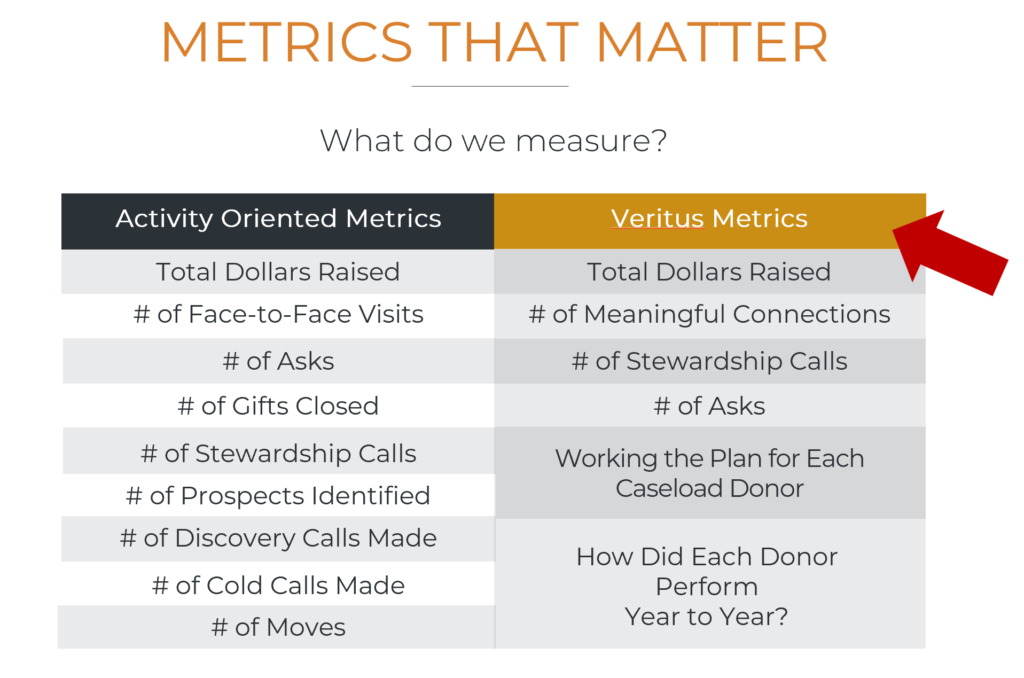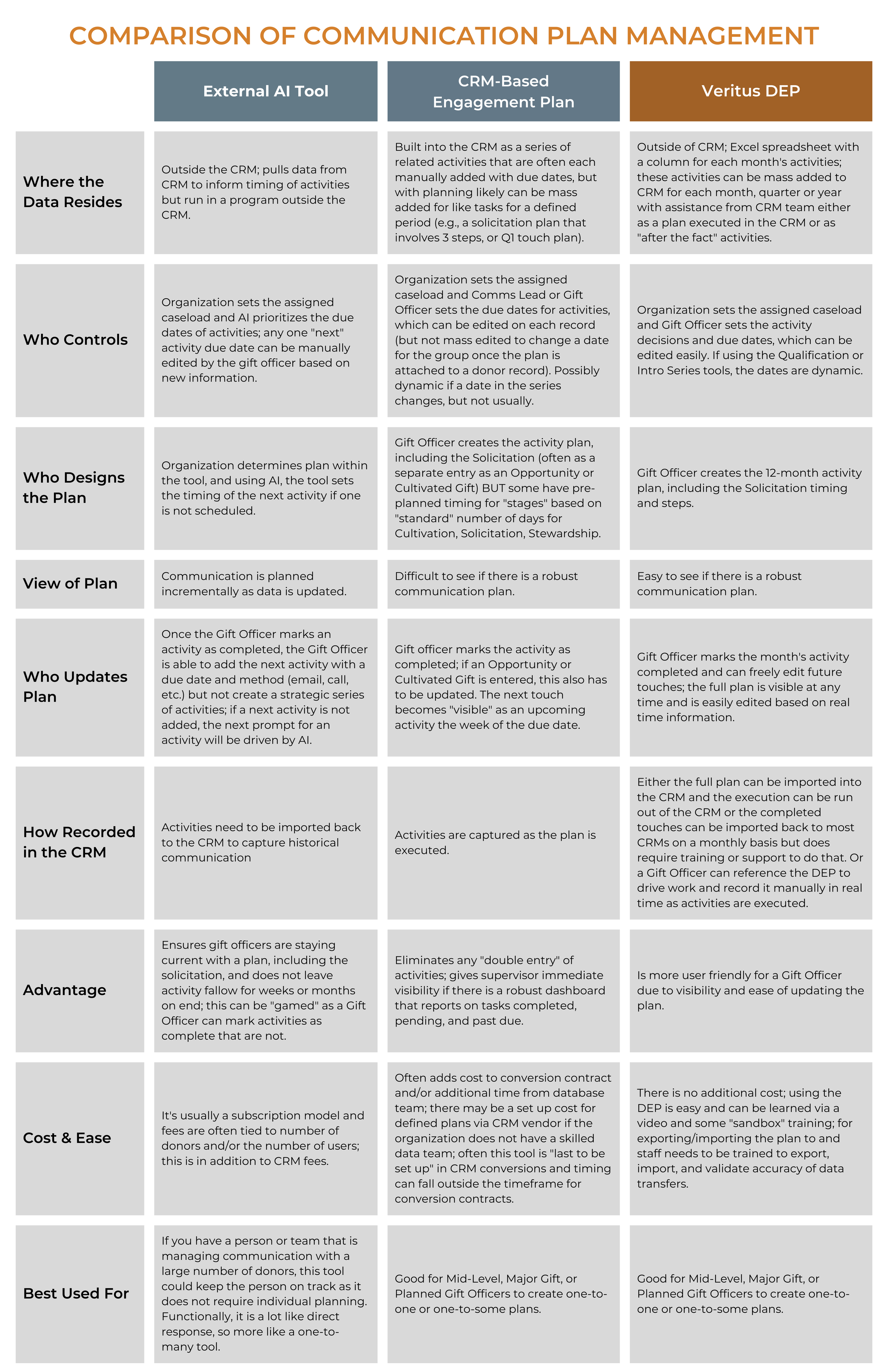Yes, I know the phrase is “can’t see the forest for the trees,” and it calls out how we can get so wrapped up in the details that we can’t see the situation as a whole. But the opposite is also true, and it’s a significant problem in relationship management fundraising.
Often, the ready-made tools in a CRM, usually through a dashboard, are generally designed to see trends and a high-level view of a caseload or fundraiser performance. There may be an activity list to show you what you need to do this week, but it’s without context. Just a checklist of “to dos.” Compounding this, the dashboard usually represents some of what a manager wants to know, not what a fundraiser needs to keep on top of each donor relationship.
When you are the relationship manager, each donor is an individual and a focus on the proverbial forest can result in losing sight of the health of each tree. The details matter. They matter a lot. Think about the resulting donor and value retention – or attrition!
So people naturally start creating a series of external lists, or Excel worksheets, or OneNotes, or whatever tool the person feels comfortable using. They are simply trying to solve the problem of “how to stay focused.” The circumstances may be different, but the theme is the same. When you are managing communication with 150 major gift donors or 500-700 mid-level donors, or 200 donors who are interested in a planned gift or have made a planned gift, the day-to-day work filled with normal interruptions during a week along with the actual task of connecting with donors in a meaningful way, makes it hard to keep up. Essentially it results in shadow databases and is not a tenable situation over time.
If you’re a manager of the team, what do you do? If you’re the database manager, how can you help? And if you’re the fundraiser, how do you cope?
At Veritus, we recommend you start with understanding the need. While managers who are development professionals are generally faster to understand, there are times when it is the finance team or program leadership who are the people making decisions about resource allocation and they likely don’t understand. On the IT or database manager side, they are juggling competing needs and it’s understandable when they are oriented to creating solutions that address the need for the program with the largest number of donors.
This means there needs to be an understanding of what is at stake. Do you have an analysis of the donor and value attrition of your donors at the $1k to $10k range? The $10k+ range? Do you know where you are stuck? Do you see the value attrition at a line-by-line view, where “new money” does not cover up “lost money”? It will be eye opening. And it will show the economic value of truly grappling with this problem. There may be a lot fewer donors in the Relationship Management programs, but they represent a huge dollar investment in your mission.
About two years ago I worked with an organization that committed to solving these problems in their CRM. They allocated staff time at the “Data & Insights” level as well as their “Salesforce Developer” level. The appropriate managers invested time. And they invested in Veritus to work with them in this process. They set up a project manager to convene the group for discussion and used software to document the identified priorities so we could stay on track. They looked at the Veritus “Metrics that Matter” chart (pictured below) and our Donor Engagement Plan to adapt the principles to the CRM, building the fields to capture information and dashboards for Gift Officer view and for Leadership view.

The result? Those changes, along with Veritus coaching for Major Gifts and Mid-Level teams, resulted in a whopping year-over-year increases in support as well as solid tracking of meaningful connections.
Here’s what happened:
Mid-Level: MLO team over time grew from 8 to 12 MLOs
- Year 1
- Revenue grew 4%
- Percent Active Donors was 83% for managed donors versus 56% for unmanaged donors
- They tracked that MLOs reached 2-way engagement with 41% of their donors, knew who they were, were trained in capturing the “Donor Story” as well as the activities, and captured the donor Interests in a more robust interest inventory
- Transferred 73 donors to Major Gifts having already given $791k and then an additional $1M after the transfer that year
- Result: they were more easily able to customize communication and when they hit Year 2 and implemented a Permission Based Asking strategy that included specific asks for each donor, it exploded
- Year 2
- Revenue grew 13%
- Overtime, 25% of these managed donors returned a donor survey (with one MLO at 38%)
- 39% of the donors had a true meaningful Interaction during the year
- Another 132 donors were transferred to Major Gifts
Major Gifts: MGO team decreased from 12 to 10 by natural attrition and better fit the number of $10k+ donors
- Year 1
- Clarity was gained on who was truly a qualified donor and which donors should be moved to Mid-Level, and with that focus…
- Revenue grew 15%
- 156 donors increased giving by $5M
- Year 2
- Revenue increased 23%
- Now cleared of trying to manage the cluster of non-Major Gift level donors, the team had the bandwidth to curate a meaningful mission event for a select number of donors with capacity to give at $100k+
- Monthly moves meetings between the respective MGO and MLO allowed for open discussion and real time CRM coding for transfers and managers ensured that received donors were set up with a new communication plan
Look, I get that this detail is a lot to absorb. So here is my suggestion: print this out and read it over again, underlining, highlighting, make notes, identifying questions. You can use these Veritus tools to help you work through this: our Free Donor File Assessment, our Relationship Management Tool Comparison chart (see below), this White Paper on Creating Strategic Plans and Goals for Every Major Donor, our Donor Engagement Plan, the Metrics that Matter chart (pictured above), etc.
Seek open conversations on how to get there. Include leadership, your manager, your database manager, all the Donor Relationship Managers. Gain agreement to solve this. Form a smaller group, invest in project management to move it through.
At the end of the day, in order to move forward and really deepen your relationships with donors to the point where you understand what they care about and how that aligns with your work, you need a tool for retrieval so you can create plans.
Our brains are not filing cabinets, and our notebooks with scribbles, excel spreadsheets, and all the different ways we try to capture this, is not sustainable. It does not honor the donor. It does not honor the mission.
If your organization can commit to finding efficiencies in your CRM to help you see and care for those trees (see how I brought that back around!), you will raise more resources to grow your mission. Then you will have a healthy, thriving, growing forest. It’s really that simple.
– Diana S. Frazier, Senior Client Experience Leader

![When you can’t see the trees for the forest A photo of trees from below [When you can’t see the trees for the forest]](https://veritusgroup.net/wp-content/uploads/2024/04/AdobeStock_159666505-scaled.jpeg)
![Keep, Lift, Move: The Three Objectives of a Successful Mid-Level Program [New Podcast Episode]](https://veritusgroup.net/wp-content/uploads/2022/08/Podcast-Episode-Blog-Post-Header-Image_080822.png)
![5 Reasons Why We Love Mid-Level, And You Should Too! [Podcast Episode]](https://veritusgroup.net/wp-content/uploads/2022/11/Podcast-Episode-Blog-Post-Header-Image-5.png)




Thank you for this reminder. Question, I will be leading a new fundraising team at a small NGO. Their CRM is Netsuite which I am not familiar with. They also have sponsor a child model which experience severe attrition rates when they finish their 10 year commitment in the community as they graduate from poverty to empowerment. The org wants to move away from sponsoring a child to a ongoing monthly program. How do you suggest we do this? I am thinking of identifying existing ML and MGs levels and build relationships. But the NGO is small and may not have the support needed to help identify them and track movement.
Great question, Sandra. We did a podcast episode on Moving Out of a Membership mindset that might address some of these questions — you can listen here: https://veritusgroup.net/podcasts/moving-out-of-a-membership-mindset/
Also, Sandra are you a member of our Community Hub? It’s a great place to get advice and connect with other fundraisers facing similar challenges. You can join the Hub here.
Thanks for reading!